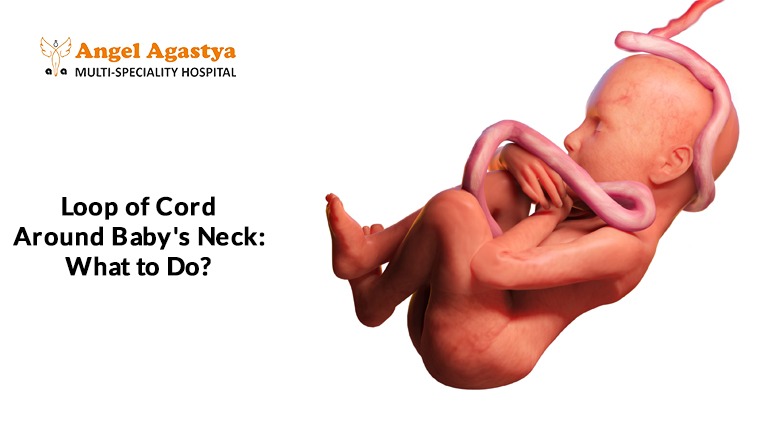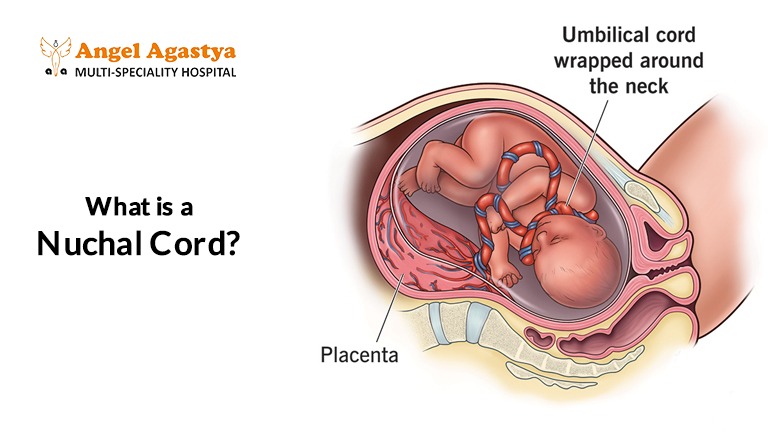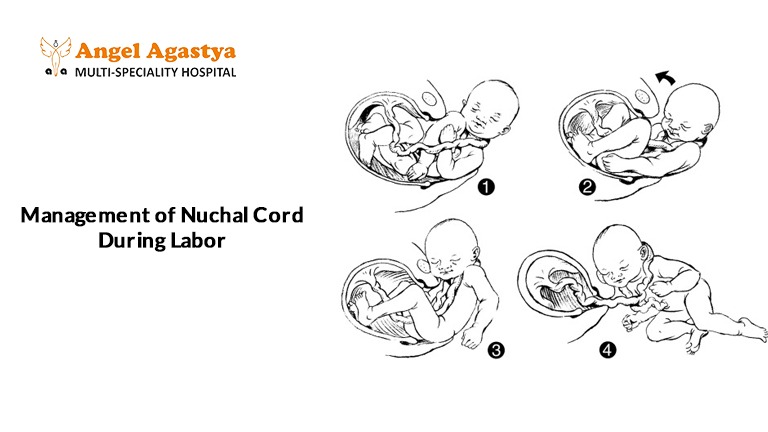Loop of Cord Around Baby’s Neck: What to Do?

A nuchal cord occurs when the umbilical cord wraps around a baby’s neck during pregnancy or labor. This is a common occurrence, happening in approximately 20-30% of pregnancies. In most cases, nuchal cords do not lead to complications, and babies are born healthy. However, it’s natural for expectant parents to have concerns. Understanding what a nuchal cord is, how it’s managed, and its potential implications can provide reassurance and prepare you for discussions with your healthcare provider.
Introduction
The thought of the umbilical cord becoming wrapped around the baby’s neck during pregnancy can be a source of anxiety for many expectant mothers. While a nuchal cord is a relatively common occurrence, it doesn’t necessarily mean there will be complications during labor and delivery. Understanding what a nuchal cord is, its causes, potential complications, and management strategies can help expectant mothers feel more informed and reassured.
What is a Nuchal Cord?

A nuchal cord refers to a situation where the umbilical cord wraps around the baby’s neck during pregnancy or labor. The umbilical cord serves as the baby’s lifeline, supplying oxygen and essential nutrients from the placenta. When the cord wraps around the neck, it is usually loose and does not always pose a significant risk. However, in some cases, a tight nuchal cord can cause complications that need medical attention.
Types of Nuchal Cords
Nuchal cords can vary in severity depending on how tightly they are wrapped and how many loops are present. The types of nuchal cords include:
- Single Loop: The cord wraps around the baby’s neck once. This is the most common type and usually does not cause complications.
- Double Loop: The cord wraps around the baby’s neck twice, which can sometimes increase the risk of complications.
- Triple Loop or More: In rare cases, the cord may wrap around the neck three or more times. This may require closer monitoring during labor and delivery.
Additionally, nuchal cords can be classified as loose or tight. A loosely wrapped cord typically does not interfere with blood flow or oxygen supply, whereas a tight nuchal cord might cause compression of the cord, affecting the baby’s oxygen levels.
Incidence of Nuchal Cord
The exact incidence of nuchal cords is difficult to determine, as they are often not detected until labor. However, studies suggest that nuchal cords occur in approximately 20-35% of pregnancies. In most cases, they do not cause harm, and many babies are born with a nuchal cord without any complications.
Causes of Nuchal Cord

The exact causes of nuchal cords are not fully understood. However, several factors may contribute to their occurrence:
1. Fetal Movement
As the baby moves inside the amniotic sac, the umbilical cord can naturally become wrapped around the neck. Frequent movements, somersaults, or rotations increase the chances of a nuchal cord developing.
2. Umbilical Cord Length
A longer umbilical cord may increase the likelihood of becoming entangled around the baby’s neck. The average umbilical cord length is around 50-60 cm, but longer cords (above 70 cm) have a higher probability of forming a nuchal cord.
3. Amniotic Fluid Levels
Excessive amniotic fluid (polyhydramnios) allows for more fetal movement, increasing the chances of the umbilical cord wrapping around the baby’s neck.
4. Multiple Pregnancies
In twin or multiple pregnancies, the risk of umbilical cord entanglement increases due to the presence of more than one baby moving within the womb.
5. Baby’s Position in the Womb
Babies that frequently change position or are very active may have a higher chance of developing a nuchal cord.
Impact of Nuchal Cord on Labor and Delivery
In most cases, a nuchal cord does not cause problems. However, there are some potential complications that doctors monitor for during labor:

Potential Complications
- Variable Decelerations: A tight nuchal cord can compress the umbilical cord, leading to temporary drops in the baby’s heart rate, known as variable decelerations. These can be observed on a fetal heart rate monitor and may require medical intervention.
- Prolonged Labor: In some cases, a nuchal cord may slightly prolong the labor process, particularly if it restricts the baby’s movement through the birth canal.
- Emergency Cesarean Section: In rare instances, if the baby experiences significant distress due to a tight nuchal cord, an emergency cesarean section may be necessary to ensure a safe delivery.
Monitoring During Labor
Continuous fetal monitoring (EFM) plays a crucial role in identifying any potential issues related to the nuchal cord during labor. This involves monitoring:
- The baby’s heart rate
- The strength of uterine contractions
- Any significant changes in heart rate that indicate distress
If concerning patterns such as prolonged decelerations are detected, the medical team will take prompt action.
Management of Nuchal Cord During Labor

Most cases of nuchal cords can be managed effectively during labor and delivery. Some common medical interventions include:
- Guiding the Baby’s Head: During vaginal delivery, the doctor or midwife may carefully slip the cord over the baby’s head or shoulders.
- Clamping and Cutting the Cord: If the cord is too tight to be slipped over the baby’s head, it may be clamped and cut before the baby’s shoulders are delivered.
- Changing Maternal Position: In some cases, changing the mother’s position during labor can help reduce cord compression and improve oxygen flow to the baby.
Important Considerations for Expectant Mothers
1. Reassurance and Mental Well-Being
It’s important to remember that nuchal cords are relatively common and do not always cause serious complications. Stress and anxiety can have negative effects on pregnancy, so staying informed and trusting the medical team can help ease concerns.
2. Regular Prenatal Checkups
Routine ultrasounds and prenatal visits help monitor the baby’s well-being and detect potential issues early. If a nuchal cord is detected on an ultrasound, the healthcare provider will discuss the best approach for monitoring and managing labor.
3. Healthy Pregnancy Practices
Maintaining a healthy lifestyle throughout pregnancy can promote overall fetal well-being and reduce the risk of complications. Recommendations include:
- Eating a balanced diet rich in vitamins and minerals
- Engaging in regular pregnancy-safe exercises
- Staying hydrated
- Avoiding smoking, alcohol, and excessive caffeine
Conclusion
While a nuchal cord can occur during pregnancy, it is important to understand that in most cases, it does not cause serious problems. With careful monitoring and experienced medical management, the majority of nuchal cords can be handled effectively during labor and delivery. Expectant mothers can approach labor with confidence by maintaining open communication with healthcare providers, attending regular prenatal checkups, and following a healthy lifestyle. By staying informed and trusting their medical team, mothers can ensure the safest possible outcome for their babies.
1. What is a Nuchal Cord?
A Nuchal Cord is a condition that occurs when the umbilical cord becomes wrapped around the baby’s neck during pregnancy or labor. This can happen due to natural fetal movements inside the womb. A Nuchal Cord is quite common and is usually not a cause for concern unless the cord becomes tightly wrapped, restricting blood flow or oxygen supply to the baby. The umbilical cord serves as the baby’s lifeline, providing oxygen and essential nutrients from the placenta, so any potential cord compression is closely monitored during pregnancy and delivery. In most cases, a Nuchal Cord does not lead to complications and can be safely managed by the healthcare team during labor and birth.
2. How Common is a Nuchal Cord in Pregnancy?
The occurrence of an umbilical cord wrapping around a baby’s neck is quite frequent, with studies estimating that 20-35% of pregnancies experience this condition at some stage. In most cases, this does not impact the baby’s health or affect the delivery process. Many babies are born with the umbilical cord around their neck and do not experience any distress or complications. The presence of the cord in this position is often discovered during labor rather than in prenatal checkups. It is important to note that this is a normal variation in pregnancy rather than a medical abnormality.
3. What Causes a Nuchal Cord to Occur?
It can develop due to various natural factors, including:
- Fetal Movement: Babies move actively inside the uterus, and during these movements, the umbilical cord can become looped around the neck.
- Long Umbilical Cord: A longer-than-average umbilical cord increases the likelihood of it looping around the baby’s neck.
- Excess Amniotic Fluid (Polyhydramnios): An increased amount of amniotic fluid allows more space for the baby to move, increasing the chance of a Nuchal Cord forming.
- Multiple Pregnancies (Twins or More): When carrying twins or more, it can be more frequent due to limited space and increased fetal movement.
While these factors may contribute to the occurrence of a Nuchal Cord, it is largely considered a normal part of fetal development rather than a medical complication.
4. Can it be Detected Before Birth?
Yes, it can sometimes be detected during an ultrasound scan, but it is not always visible. If it is found during an ultrasound, it is usually observed rather than treated because, in most cases, it does not cause any harm to the baby. Doctors may use color Doppler imaging to determine the presence and tightness of the Cord.
Even if it is detected before birth, it does not necessarily mean there will be complications. Most babies with a Cord continue to grow and develop normally in the womb. If any concerns arise, the doctor may recommend additional monitoring to ensure the baby remains healthy and active.
5. Does it Cause Complications During Delivery?
In most cases, it does not cause complications during labor and delivery. However, in rare cases, a tight Cord can lead to:
- Variable Decelerations: It may cause occasional drops in the baby’s heart rate due to cord compression. These temporary changes are monitored closely by medical professionals.
- Prolonged Labor: It may slightly slow the descent of the baby through the birth canal, leading to a longer labor.
- Fetal Distress: If it is tight and restricts oxygen flow, the baby may show signs of fetal distress, prompting medical intervention.
- Cesarean Section: In rare cases, if it causes severe distress, an emergency C-section may be necessary to ensure the baby’s safety.
Despite these possibilities, the majority of the cases resolve naturally without intervention.
6. How is a Nuchal Cord Managed During Labor?
During labor, if it is detected, the healthcare provider will take necessary steps to manage it safely:
- Gentle Loop Removal: If it is loosely wrapped, the doctor or midwife may gently slip it over the baby’s head or shoulders during delivery.
- Somersault Maneuver: In some cases, a baby with a Cord may be delivered using the somersault maneuver, allowing the shoulders and body to come out while the cord remains in place.
- Cord Clamping and Cutting: If the Cord is tight and restricting movement, doctors may clamp and cut the umbilical cord before the shoulders are delivered.
With continuous fetal monitoring, doctors ensure that any Cord does not pose a serious risk to the baby’s well-being.
7. Can a Nuchal Cord Be Prevented?
There is no guaranteed way to prevent a Nuchal Cord, as it results from natural fetal movement. However, steps to promote a healthy pregnancy and fetal positioning include:
- Attending regular prenatal checkups to monitor fetal well-being.
- Practicing good maternal posture to encourage optimal fetal positioning.
- Staying hydrated and maintaining a balanced diet for overall pregnancy health.
Since a Nuchal Cord is often unpredictable, early detection through prenatal monitoring is the best approach.
8. Is a Nuchal Cord Dangerous for the Baby?
It is usually not dangerous, and most babies with a Cord are born healthy. However, in rare cases, if the Cord is very tight, it may:
- Restrict oxygen supply if the cord becomes compressed.
- Lead to fetal distress, requiring immediate medical intervention.
- Cause delivery complications, making labor more prolonged.
With modern medical advancements, doctors can easily manage a Cord to ensure a safe delivery.
9. Should I Be Worried if My Baby Has a Nuchal Cord?
No, it is common and not a cause for alarm in most cases. If a it is detected, doctors will closely monitor the baby’s heart rate and well-being to ensure there are no complications. Most babies born with a Cord do not experience any negative effects.
Staying informed, maintaining open communication with your doctor, and following recommended prenatal care will help ensure a smooth and safe pregnancy.
10. What Should I Do if My Baby Has a Nuchal Cord?
If a it is detected during an ultrasound or labor, here’s what you should do:
- Stay Calm: It is usually harmless and can be managed effectively.
- Follow Your Doctor’s Advice: Your healthcare provider will monitor the situation and take necessary precautions.
- Trust the Medical Team: Skilled obstetricians, nurses, and midwives are experienced in handling Cord cases, ensuring a safe delivery.

